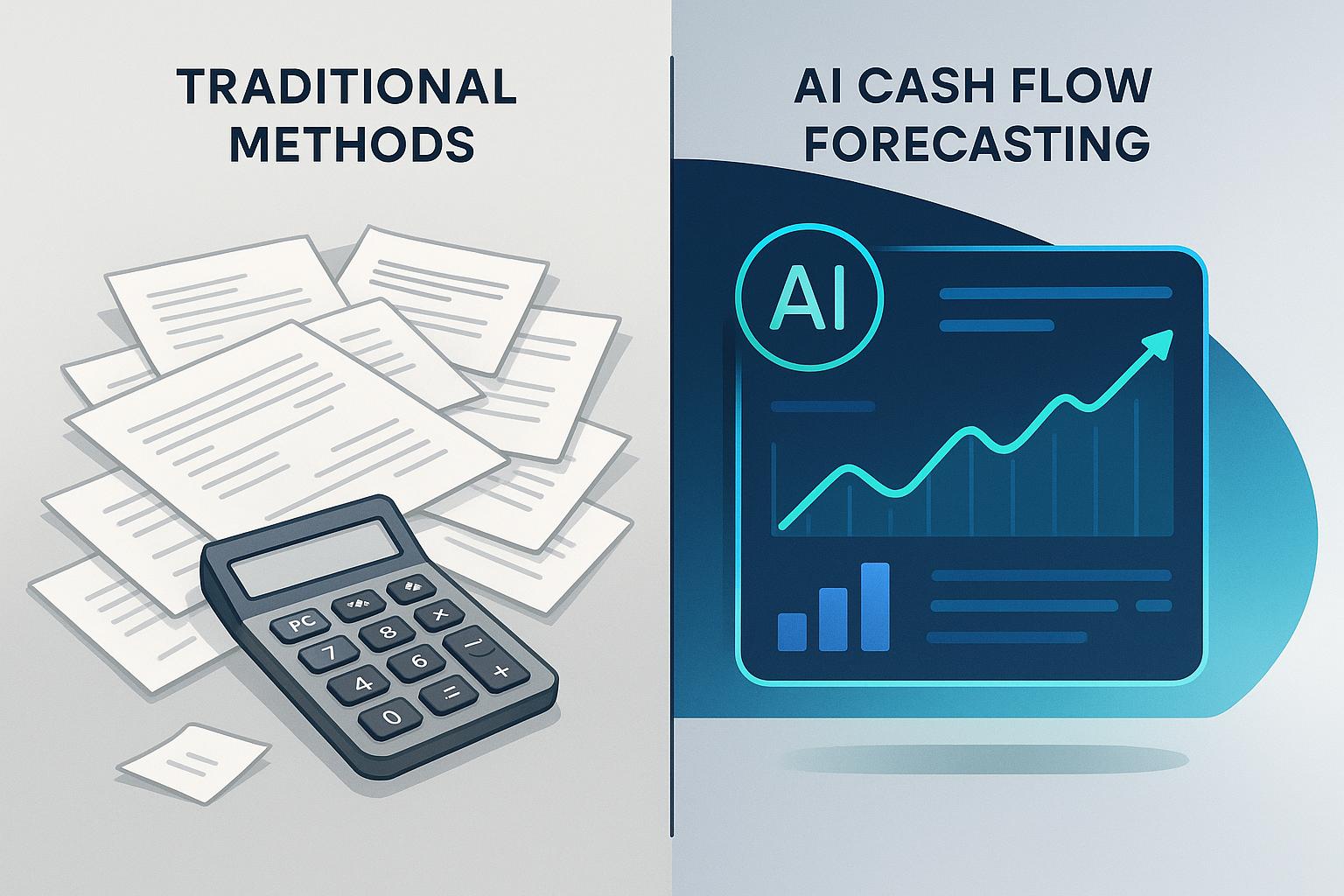Managing your debt-to-equity ratio is crucial for maintaining a healthy financial structure, especially for startups and small businesses in the U.S. AI tools like Lucid Financials, Tool B, and Tool C simplify this process by providing real-time analysis, integration with accounting systems, and automated financial reports. Here's what you need to know:
- Lucid Financials: Offers real-time monitoring, QuickBooks integration, scenario planning, and industry benchmarks. Pricing ranges from $50/month for startups to custom plans for enterprises.
- Tool B: Focuses on real-time insights, historical trend analysis, and predictive modeling. Best suited for businesses prioritizing data accuracy and team training.
- Tool C: Requires careful evaluation for integration, customization, and real-time insights. Ideal for businesses with unique workflows.
Quick Comparison
| Tool | Key Features | Ideal For | Pricing |
|---|---|---|---|
| Lucid Financials | Real-time updates, scenario planning, industry benchmarks | Startups, SMBs, enterprises | $50-$600/month, custom for enterprises |
| Tool B | Historical trends, predictive modeling, customizable reporting | Data-driven businesses | Custom pricing |
| Tool C | Flexible integration, real-time insights | Unique business workflows | Custom pricing |
Pro Tips:
- Use tools with QuickBooks and payroll integration for seamless data management.
- Regularly monitor real-time updates to make informed financial decisions.
- Choose features that align with your business size and industry needs.
AI tools are transforming how businesses optimize their debt-to-equity ratios, making financial management faster, more accurate, and easier to scale.
AI for M&A, VC and Debt Financing Deals: How to use GiveFlag
1. Lucid Financials

Lucid Financials uses AI to streamline debt-to-equity management, offering real-time analysis and practical insights. Its main strengths focus on three areas that directly impact financial ratio management.
Automated Financial Analysis
The platform’s AI engine tracks financial data continuously through integrations with QuickBooks and banking systems, providing instant debt-to-equity calculations and alerts. This automation removes the need for manual calculations and reduces errors.
| Feature | How It Helps with Ratio Management |
|---|---|
| Real-time Monitoring | Provides instant updates on ratio changes |
| QuickBooks Integration | Syncs financial data automatically |
| Bank Connections | Tracks debt obligations in real time |
| Payroll Integration | Ensures accurate equity tracking |
These real-time updates feed directly into the platform’s advanced planning tools.
Scenario Planning Tools
Lucid Financials allows businesses to model various debt-to-equity scenarios before making decisions. With the Professional plan, users can explore unlimited scenarios to:
- Evaluate different debt financing options
- Assess the effects of equity dilution
- Simulate changes to capital structure
- Compare potential funding strategies
Industry Benchmarking
The platform offers sector-specific benchmarks to help businesses align their debt-to-equity ratios with industry standards. This feature is especially useful for startups and small-to-medium businesses looking to grow while maintaining competitive capital structures.
The Professional plan, priced between $150 and $600 per month, includes a wide range of features, while the Enterprise plan provides tailored solutions. With AI-driven modeling and real-time updates, Lucid Financials ensures businesses manage their capital structures effectively and stay on top of their current financial position.
2. Tool B
Tool B offers another example of how AI can simplify debt-to-equity management. It uses advanced technology to make financial analysis and decision-making easier and more efficient.
This platform integrates with accounting, banking, and payroll systems, providing real-time insights. It also includes features like historical trend analysis, customizable reporting, and predictive modeling to help guide financial strategies.
To get the most out of Tool B, businesses should focus on a few key practices:
- Conduct regular data audits to ensure accuracy.
- Provide thorough training for team members.
- Periodically review settings to keep everything aligned with financial goals.
These steps help businesses use AI effectively to manage debt-to-equity ratios while staying on track with their broader financial plans. This highlights how automated, data-driven tools can support healthier capital structures and smarter financial decisions.
sbb-itb-17e8ec9
3. Tool C
The specific features of Tool C for optimizing debt-to-equity ratios are not clearly defined. To determine if Tool C is the right fit, businesses should carefully assess how well it aligns with their financial goals. Here are some critical factors to consider when evaluating any financial tool:
- Data Integration: Can the tool connect smoothly with your existing financial systems and data sources?
- Real-Time Insights: Does it provide up-to-date analysis of key financial metrics?
- Customization: Are there options to tailor the tool to meet the unique needs of your industry?
It's also important to consider how well the tool fits into your current workflows, the ease of training staff to use it, and whether it can grow with your business. A successful implementation depends on thoughtful planning, regular monitoring, and making adjustments as needed. Take the time to evaluate these aspects thoroughly before committing to Tool C.
Features and Limitations
Lucid Financials stands out with a range of detailed tools designed for various U.S. businesses, offering both advantages and a few challenges.
Key Features
- Real-Time Integration: Provides up-to-date financial insights by integrating data as it comes in.
- Scenario Planning: Available in the Professional and Enterprise plans, allowing unlimited forecasting scenarios.
- Sector-Specific Tools: Tailored for industries like e-commerce, startups, professional services, and manufacturing.
- Enterprise-Level Options: The Enterprise plan includes unlimited collaborators and customizable AI-driven financial plans.
- Expense Management: The Professional plan tracks expenses up to $500,000 per month.
- Flexible Pricing: Options range from a free basic model to custom pricing for enterprise solutions.
Challenges to Consider
- Data Accuracy: Businesses with unique processes may need to double-check AI-generated insights to ensure they align with their specific needs.
- Industry-Specific Adjustments: While it caters to many sectors, including manufacturing with high capital demands, the AI's performance can vary depending on the business model.
- Implementation Hurdles: Adopting the platform may require staff training, data migration efforts, and adjustments to existing workflows.
Lucid Financials delivers robust tools but requires careful consideration of these limitations to maximize its effectiveness.
Summary and Recommendations
Here’s a breakdown of the suggested plans:
| Business Type | Recommended Plan | Key Features |
|---|---|---|
| Early-stage Startups | Starter ($50/mo) | Integration with QuickBooks and payroll, basic scenario planning, expense tracking up to $70,000/month |
| Growing SMBs | Professional ($150-$600/mo) | Advanced financial modeling, unlimited scenario planning, higher expense limits per month |
| Enterprise & Manufacturing | Enterprise (Custom) | Unlimited team access, advanced integrations, fully customizable options |
| Multi-client Firms | Accounting & CFO (Custom) | Manage multiple companies with specialized features |
Based on the earlier analysis of tools, here are some practical steps to maximize these plans:
- Set clear financial and operational goals.
- Take full advantage of integrations with tools like QuickBooks and payroll systems.
- Regularly monitor real-time data for better decision-making.
- Scale features as your business grows and evolves.
A user’s experience highlights the platform’s impact:
"Lucid has made it incredibly easy to track spending, plan ahead, and handle our growth. It's straightforward and effective. Managing my finances has become much easier with this platform. It's user-friendly and efficient, saving me a lot of time and effort." - Aviv Farhi, Founder and CEO @Showcase
For businesses in sectors like manufacturing or e-commerce, the Enterprise plan provides tailored options to address industry-specific financial needs. This ensures that insights and recommendations are aligned with the unique challenges and goals of each organization.


